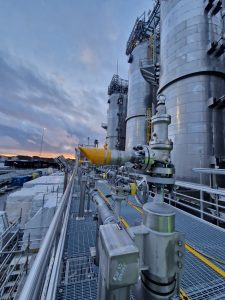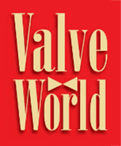Basing safety valve capacity solely on outlet connection size rather than required flow rate can lead to dangerous over-pressurization of protected vessels.
By Artur Cardozo Mathias

Aserious error that we have seen is the specification of the safety valve based on the dimensions (gauge) of the connection (whether threaded, flanged or welded) of the equipment outlet (pressure vessel, mainly), to which the valve will be installed. Specifying, selecting and installing safety valves based only on outlet size rather than required flow rate is a serious error some users make. It can lead to dangerous pressure accumulation beyond safe limits due to high inlet pressure drop when the installed valve is undersized. This causes restricted flow through the valve nozzle.
For pressure vessels, the maximum allowable pressure accumulation is 10% or 3 psi above set pressure, whichever is greater, when protected by one valve at or below MAWP. With multiple valves, the limit is 16% or 4 psi. Meeting these requires proper valve sizing and installation. Exceeding these pressure limits can occur if inlet piping has a smaller internal area than the valve inlet. The pipe will restrict flow below the valve capacity, potentially damaging valve components and causing chattering due to excessive inlet pressure drop.
One of the main causes for the occurrence of this operational phenomenon (chattering) with safety valves (mainly when operating with gases and vapors) is precisely the high pressure drop in the inlet pipe caused by a pipe smaller than the valve inlet connection. The occurrence of chattering always causes a reduction in the nominal flow capacity value marked on the valve nameplate.
Therefore, safety valves must be specified, sized and installed to meet regulatory requirements such as ASME Section VIII (pressure vessels) and API Std. 520 Part 1 (sizing and selection of safety valves for pressure vessels), API Std. 520 Part 2 (installation of safety valves in pressure vessels) and API Std. 526 (dimensions of effective nozzle area, center-to-face dimensions, etc. of valves to be installed for vessel protection constructed in accordance with ASME Section VIII – Division 1). Since API Std. 526 determines the sizes of inlet, outlet connections and nozzle orifice area, therefore, for each selected orifice (and according to the flow capacity required by the process), after sizing calculations, there will be a correct combination of dimensions for entry and exit, in addition to the orifice.
Flow capacity required by the process
The process flow rate is the most critical factor for determining the required nozzle orifice area and subsequent inlet/outlet sizes. API 526 provides standard dimensions but should not be used for sizing valves.
It is only applicable after proper sizing calculations are completed. It standardizes dimensions like center-to-face lengths for flanged valves. This is useful when discharging into a collector with fixed outlet piping. API 526 allows swapping valves from different manufacturers while maintaining dimensions and flow capacity (given the same Kd discharge coefficient). This prevents reworking piping, reducing valve changeout costs.
Proper inlet and outlet piping design is crucial for safety valve functionality. The inlet piping size and length limits in ASME Code Section VIII and API Standard 520 Part II keep pressure drop within acceptable values, preventing disc chatter and flow capacity reduction compared to the valve’s nameplate rating. However, these requirements cannot be met if the inlet diameter is less than the valve inlet connection diameter, or the length exceeds 5 times the nominal inlet pipe diameter.
Per ASME Code Section VIII Appendix M6 (Non-Mandatory) and API Standard 520 Part II, non-recoverable inlet pressure losses must be limited to 3% of the safety valve’s set pressure at the nameplate flow rate. Exceeding this limit can cause disc chatter, rapidly cycling against the nozzle seat.
“Remember that safety valves protect
not only equipment, but more importantly, human lives.”
Chatter reduces available flow capacity compared to the nameplate rating. Following ASME and API guidelines assists with appropriate inlet sizing to avoid excessive pressure losses. Additionally, ASME Code Section VIII Appendix M7 and API Standard 520 Part II provide discharge piping pressure drop limits. For conventional unbalanced safety valves, the maximum allowable outlet pressure drop is 10% of set pressure during a 10% overpressure relief scenario. If the discharge diameter is less than the valve outlet connection diameter, two detrimental effects can occur:
- Flow capacity decreases below nameplate rating from increased friction
- Back pressure develops from higher pressure drop
Meeting the 10% limit on discharge pressure loss requires proper sizing of the valve and piping based on calculated nozzle flow area. This yields predefined inlet and outlet dimensions matched to the required flow rate. Adhering to these established guidelines prevents inlet and outlet restrictions from reducing valve capacity.
Internal area of the pressure vessel outlet nozzle
Therefore, the internal area of the piping between the outlet of the protected equipment and the inlet of the safety valve must be equal to or greater than the area of the valve inlet connection. Likewise, the internal area of the discharge piping must be equal to or greater than the internal area of the valve outlet connection.
Thus, according to the nozzle area selected for the flow capacity required by the process, it is only the nozzle area that must determine the dimensions of the valve inlet and outlet pipes defined by API Standard 526 for pressure vessels.
With a valve installed whose flow capacity is limited by the pipe dimensions, in addition to increasing the internal pressure of the protected equipment (pressure vessel), it can also cause the closing pressure of the valve to approach the operating pressure of that equipment. This prevents complete closure and sealing of the valve, a phenomenon referred to as simmering.
Conversely, if the valve is installed in a pipeline whose internal diameter is larger than necessary, the valve will be oversized. In addition to causing operational problems like chattering, an oversized valve also results in greater weight and support requirements, increasing costs. A safety valve is considered oversized whenever the process flow rate is less than 30% of its rated flow capacity.
Final conclusions
Meeting regulatory requirements for installing safety valves on pressure vessels falls to the end user. Vessel manufacturers are not obligated to provide safety valves. The end user must identify potential overpressure causes, choose appropriate protection methods, and properly size and select the most suitable pressure relief device based on process needs.
Users must remember that safety valves protect not only equipment, but more importantly, human lives. Those responsible for specifying, purchasing and maintaining safety valves will not be exposed to the hazards of inadequate protection caused by improper valve installation. Compliance with codes and standards ensures properly designed safety valve systems that reduce operational risks.
About the author
 Artur Mathias is in Industrial Mechanical and Chemical Technician and a Member ISA. Now a consultant, he has been active since 1985 in the maintenance, inspection, specification and sizing of valves. Arthur provides training and technical courses, and is the author of the book Válvulas: Industriais, Segurança e Controle.
Artur Mathias is in Industrial Mechanical and Chemical Technician and a Member ISA. Now a consultant, he has been active since 1985 in the maintenance, inspection, specification and sizing of valves. Arthur provides training and technical courses, and is the author of the book Válvulas: Industriais, Segurança e Controle.
About this Technical Story
This Technical Story is an article from our Valve World Magazine, March 2024 issue. To read other featured stories and many more articles, subscribe to our print magazine. Available in both print and digital formats. DIGITAL MAGAZINE SUBSCRIPTIONS ARE NOW FREE.
“Every week we share a new Technical Story with our Valve World community. Join us and let’s share your Featured Story on Valve World online and in print.”

